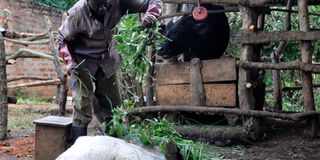LRA war victims beat odds to succeed in dairy farming

Mr Patrick Ben Oloya chops pastures to feed his cow in Koro-pida Village, Koro Sub-county, in Omoro District last week. PHOTO | TOBBIAS JOLLY OWINY
What you need to know:
- Background. Despite the presence of vast land, water and abundant quality grasses to facilitate livestock breeding, northern Uganda still ranks as the least producer of beef and milk in the country with 14 per cent of the total production MSC has registered success in orienting farmers to take up farming as a business.
An aura of happiness hangs over Ms Joska Acoro’s home in Awic Village, Unyama Sub-county in Gulu District.
In the compound, there is an unusual sight of piles of freshly cut grass to feed a Friesian cow and a heifer in the backyard.
Every day, Ms Acoro wakes up at 6am to clean the kraal and wash the cans for the 7am milking schedule. Upon delivering the milk at Unyama Trading Centre, she returns to look for fresh grass to feed the cows.
“Once I bring the grass, my husband feeds them and does the afternoon milking. Once we are done with the crop harvest, we should be able to roof our new building and refurbish the kraal since the mother cow is expectant,” Ms Acoro says.
Together with her husband, Mr Michael Opira, the couple is spreading in the sun 16 bags of groundnuts they recently harvested and expects another 10 bags of maize from a field that is nearing harvest.
The outbreak of the LRA war in 1986 did not only claim thousands of lives but rid the region of the remaining livestock since people were forced into displaced people’s camps.
As the region recovers from the impact of the conflict, Ms Acoro is one of the 46 peasants in Gulu and Omoro districts who are reaping from milk production.
“Initially, I was criticised for going for dairy cows but when I started selling the milk, a lot of women come home to seek advice on starting it, I can now deposit the biggest amount of money in our Ribe-ber VSLA group,” she said.
Looking back
In 2017, the Microfinance Support Centre Ltd (MSC), a government credit financial institution, partnered with Heifer International, a local NGO, to provide dairy animals on loan to farmers in Unyama and Koro sub-counties of Gulu and Omoro districts, respectively.
A total of 46 dairy animals were given to farmers upon vetting.Farmer groups, associations and cooperative societies were assessed to define their vulnerability.
The beneficiaries were then subjected to training in finance management and dairy production.
Five of the 46 beneficiaries visited by Daily Monitor were able to afford meals, meet household expenses every day as well as pay school fees for their children from the money raised from milk sales.
Mr Patrick Ben Oloya, a 63-year-old resident of Koro-pida Village, Koro Sub-county in Omoro District, is one such beneficiary who received a heifer worth Shs3.3million under the loan scheme in 2018.
“A lot of things have changed since I got the cow that has now produced two other animals. From the cow, I and my family get milk, and I sell some of it to service the loan with MSC, pay medication and food bills,” he says.
From his record books, the cow gives Mr Oloya eight to 10 litres of milk a day, which translates to between Shs16,000 and Shs20,000 per day.
Mr Joel Ludwali, MSC’s credit officer for the northern region, said government embarked on a venture that primarily intended to improve livelihoods and household incomes of the vulnerable poor.
“The target of this initiative was to eradicate poverty and demystify a belief that diary or beef production were unavailable in the region even when all the production factors are lying idle and wasting away,” Mr Ludwali said.



